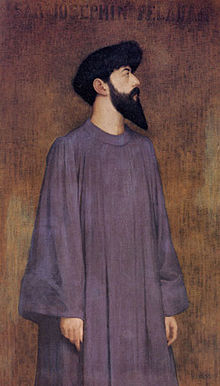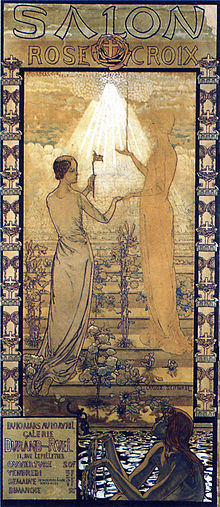Joséphin Péladan
Joséphin (Joseph) Péladan called "Sâr" Péladan (born March 28, 1858 near Lyon , † June 27, 1918 in Neuilly-sur-Seine ) was a French writer and occultist . In 1888 he founded the Ordre Kabbalistique de la Rose-Croix in Paris with Stanislas de Guaita , but broke with Guaita in 1890 because of his satanic sentiments, and founded the Catholic Rosicrucian Order Ordre de la Rose-Croix Catholique .
Live and act
Péladan came from a traditional Catholic family in Lyon . His father was a teacher, published a Catholic and monarchist magazine and tried, among other things, to initiate a cult around the (hypothetical) 6th wound of Jesus . Péladan's oldest brother, Adrian, was a homeopath , Kabbalist and Orientalist. He dealt with mysticism and donated his large hermetic library to Joséphin.
After a brief employment contract with a Parisian bank company, Péladan traveled to Rome and Florence , where he dealt intensively with the works of Leonardo da Vinci and the Renaissance in his numerous writings and studies , and he also had a preference for the works of Miguel de Cervantes and Richard Wagner's music theater (primarily Parsifal ) and, according to Wagner's works, liked to dress in white tunics with sky-blue stripes.
In 1888 Péladan founded the Ordre Kabbalistique de la Rose-Croix ( Kabbalistic Rosicrucian Order ) with Stanislas de Guaita . Since Péladan soon felt repulsed by de Guaitas' satanic orientation and he was disturbed by the theosophical Indian influences, he began to combine his esoteric interests more with a Catholic piety, and in June 1890 founded a Rosicrucian order of Catholic provenance, the Ordre de la Rose -Croix Catholique et esthétique du Temple et du Graal .
In 1892, Péladan organized the first Rosicrucian gathering at the famous Durand-Ruel gallery in Paris . Artists such as Émile Bernard , Emil-Antoine Bourdelle , Jean Delville , Emile Fabry , Ferdinand Hodler , Fernand Khnopff and Georges Minne take part in the annual exhibitions from 1892 to 1897, called “Salon de la Rose-Croix” . Out of love and admiration for his second wife, the art critic Christiane Taylor , Péladan soon renounced his eccentric lifestyle and rarely went public. In 1908 Péladan was awarded the Prix Charles Blanc for his life's work by the Académie française . Joséphin Péladan died almost forgotten in Paris in 1918.
Works (selection)
- Le Vice suprême , (German: The highest vice ), first volume of La Décadence Latine , novel 1884
- Curieuse, 1885
- L'Initiation sentimentale, 1887
- Isthar, 1888
- Comment on devient mage, 1891
- Babylone, tragédie, 1895
- Le Prince de Byzance, tragedy, 1896
- Œdipe et le Sphinx, tragédie en prose, 1903
- Sémiramis, tragédie en prose, 1904
- La Dernière Leçon de Léonard de Vinci, essai, 1904
- De Parsifal à don Quichotte, essai, 1906
Translations
- Peladan: The almighty gold. Roman, translated into German by Emil Schering. 3. Edition. Georg Müller Verlag, Munich 1918, DNB 36363973X .
literature
- Grete Wehmeyer: Erik Satie. Gustav Bosse Verlag, Regensburg 1974, ISBN 3-7649-2077-7 . (Studies on the History of Music in the 19th Century, Volume 36)
- Jacques Lethève: Les Salons de la Rose-Croix. In: Gazette des Beaux-Arts , Vol. 56, 1960, pp. 363-374.
- Robert Pincus-Witten: Occult Symbolism in France. Joséphin Péladan and the Salons de la Rose-Croix. Garland Publishing, New York 1976, ISBN 0-8240-2003-0 .
- Christophe Beaufils: Le Sâr Péladan. Biography critique. Aux amateurs de livres, Paris 1986, ISBN 2-905053-19-4 .
- Rainer Rutkowski: Literature, art and religion in the fin de siècle. Investigations into the work of “Sâr” Péladan (1858–1918). Dissertation. Bonn 1989, DNB 891546812 .
- Isa Bickmann: Leonardism and Symbolist Aesthetics. A contribution to the history of Leonardo da Vinci's impact in Paris and Brussels. Frankfurt 1999, ISBN 3-631-34146-6 .
Individual evidence
- ↑ a b The Ordre Kabbalistique de la Rose-Croix in: Material for the book: New Rosicrucians by Harald Lamprecht .
- ↑ An overview of the participants in: R. Pincus-Witten: Occult Symbolism in France. Joséphin Péladan and the Salons de la Rose-Croix. New York 1976, p. 217.
Web links
| personal data | |
|---|---|
| SURNAME | Péladan, Joséphin |
| ALTERNATIVE NAMES | Péladan, Joseph |
| BRIEF DESCRIPTION | French author |
| DATE OF BIRTH | March 28, 1858 |
| PLACE OF BIRTH | Lyon |
| DATE OF DEATH | June 27, 1918 |
| Place of death | Neuilly-sur-Seine |


